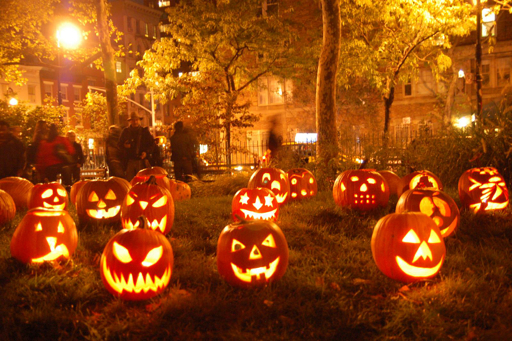Origins of the Top 10 Halloween Traditions

By this point in life, it would not be too presumptuous to assume that you know the basic origins behind Halloween. For those who do not, it is based around the Gaelic harvest festival Samhain, which was historically celebrated from October 31st through the eve of November 1st. In a practical sense, this was the day the livestock were taken in for the winter, the bulls slaughtered, and the last crops harvested for the year. It was marked by a day long festival, and superstition. Many of these superstitions have helped to create the holiday we all know and love today, while some traditions have much more contemporary origins. Here are the top ten Halloween traditions and their origins!
- Pranks
Pranks have always been a part of the Celtic Samhain celebration, even before they became the defining element of Cabbage Night, aka Mischief Night (October 30). The act of dressing up to fool returned spirits, was just the beginning of the mischief aspect of the festival. As Christianity spread, All Hallow’s Eve became absorbed into All Saints Day or All Souls’ Day in Great Britain, leaving the hijinks of their Gaelic affair in the dust. That is until 1605, when November 5th came to be known as Guy Fawkes Night (still celebrated in England) to celebrating the plot to blow up Parliament. Once again, trackers and mayhem became part of Halloween only to be carried over to the US with the English, Irish, and Scottish settlers.
- Bobbing for Apples
This game was not originally a part of Samhain. Rather, it has its origins in a Roman festival honoring Pamona, an agricultural goddess. It was thought that through bobbing for apples, players would receive a glimpse of their future. When the Romans conquered Britain, this ritual easily found a place among the Samhain festivities, where it remains to this day.
- Candles
Lighting candles (or large bonfires among the Celts) was an integral part of Samhain. They believed that the returned spirits required light so that they did not lose their way on the journey back to the afterlife.
- Black Cats
Black cats (and just cats in general) were seen as a symbol of good luck among most pre-Christians. The Celtic in particular saw these little felines as immensely fortuitous in their everyday life. It was not until the spread of Christianity, that black cats got a bad name (so as to single “pagans” out from converts. Their tie to Halloween likely started with the Celts and Samhain, but their dark symbolism was not cemented until the Middle Ages when black cats were thought to be familiars, or magical companions of the witches.
- Black and Orange Everything
This one is as traditional as it gets. For the ancient Gaelic, black represented the death of summer, while orange represented the coming of autumn. Death and rebirth….pretty simple isn’t it?
- Witches
For everyone out there who has ever seen Hocus Pocus (a Halloween classic!), the relationship between witchcraft and Halloween seems pretty obvious; it’s the one night a year when they can commune with spirits, thus raising their power so as to perform more evil deeds. Well, this is partially true. Samhain is the one day a year where spirits roam freely across the living world, but for the typical witch, this offers the opportunity to communicate with spirits, not gobble up the life forces of children. The connection of witches to Halloween also dates back to Samhain and the spread of Christianity. Those that did not convert were seen as devil worshippers by early Christians. Traditional Samhain rituals then became satanic fanfare, and those participating were witches, black cats and all. Luckily, this has changed significantly over the years and witches have just become another festive symbol of this fun holiday.
- Jack-o-Lanterns
This tradition has a pretty interesting back story. As it goes, there was an Irishman named Stingey Jack who trapped the Devil inside of a turnip, refusing to let the demon go unless he swore that Jack would not go to Hell when he died. As it turned out though, Heaven didn’t want Jack either, so he was left a wandering soul in the earthly realm. Feeling uncharacteristically sympathetic to poor Jack’s plight, the Devil gifted him a lump of burning coal to light his way on his never ending journey in the land of the living. Jack put this lump in his turnip and used it as a lantern to light his way. On All Hallows’ Eve, when the spirits of the dead return to the land of the living, pumpkins are carved to both frighten away spirits, and provide them with light so that they can find their way back to death.
- Candy
When Halloween was first adopted by the Christians as all Saints Day, it was customary for peasants to visit wealthier citizens in and be given a treat, usually coins or food. This tradition stuck, and even after All Saints Day became the much more popular Halloween, children and other trick-or-treaters would be given coins or trinkets. This lasted until the 1950s when US candy companies began to market Halloween as a time for sweets, not pennies. Pretty smart advertising, considering how Americans buy 600 million pounds of candy the week before and of Halloween, whereas they only purchase 300 million pounds in the rest of the year combined!
- Trick-or-Treating
Perhaps the most important of all the traditions, Trick-or-treating as it is done in the US, is thought to be a combination of two traditions. The first comes from Samhain, in which Celts would leave out treats and food as offerings to the dead. The other comes from an old practice in German-American communities, beltsnicking, where children would dress up in costumes and go around to their neighbors to see if they could guess who the disguised children were. Put the two together and you get millions of children dressing up and chasing a sugar high…. puts a smile on the face, doesn’t it?
- Costumes
Halloween just wouldn’t be Halloween if not for the costumes. From skanky bunnies, to witches, goblins, Freddie Kruger, superheroes, and everything in between, if nothing else, this holiday is all about dressing up in the most extravagantly weirdest way possible. Traditionally, this meant dressing up as ghosts and other otherworldly creatures for the sole purpose of hiding from the dead. The Celts of Samhain believed that returned spirits would not be able to recognize them through such elaborate disguises. Today this most beloved tradition has endured, and though we may no longer use it to hide from ghosts, it allows us to be whoever or whatever we want for a night and get candy: totally worth it!






